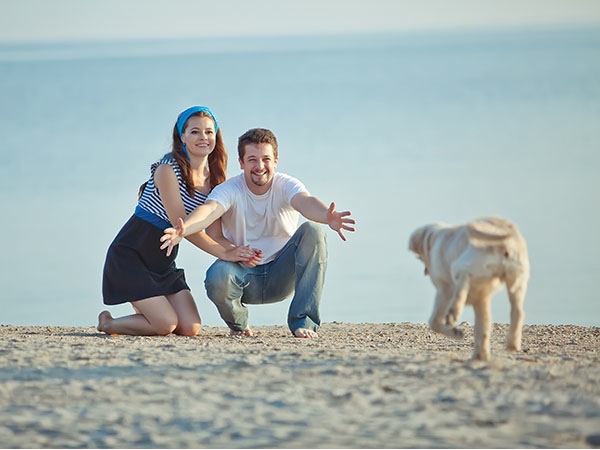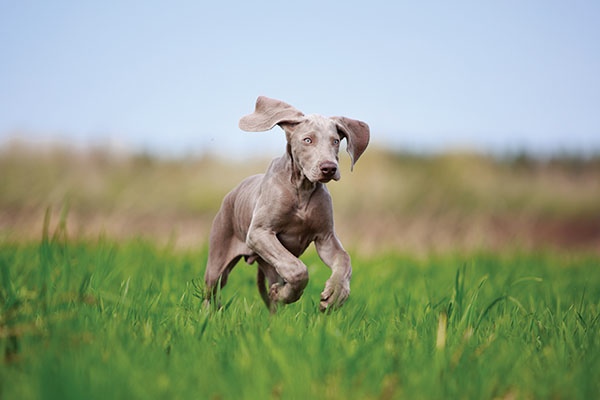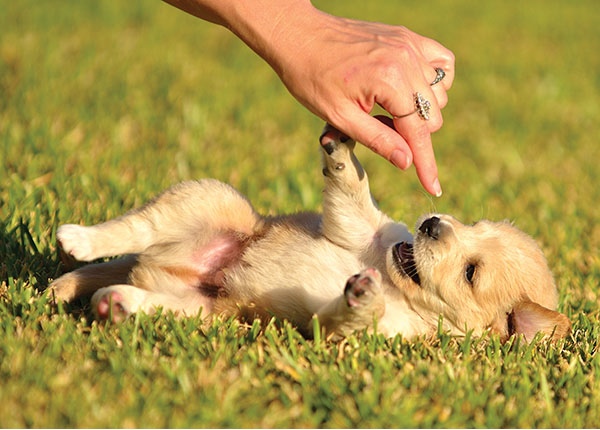Chapter 3: Daily Routine
Your puppy may take a few days to a few weeks to settle in—depending on his age, temperament, and from where and whom you acquired him. No set time schedule exists for introducing him to his new home and environment. You will need to work with your puppy according to his individual temperament and personality—always progressing at a speed that is within his comfort zone. He may have quirks and idiosyncrasies that you will need to recognize and manage; in many instances, these ingrained behaviors are managed rather than cured.
Ideally, you will want to start right away establishing a daily schedule and routine. Dogs are creatures of habit and thrive on guidance, boundaries, and a regular routine. Granted, some puppies are more challenging than others, and his first weeks home may not be the “honeymoon period” you had envisioned. However, no matter how pitiful his eyes—you must establish and stick to a daily routine. Your puppy will adjust to his new life in your home much more quickly and easily if you provide some order to his life.
Puppies are like sponges—absorbing all sorts of information at this young age. By setting a routine and sticking to it, you can begin instilling desired behaviors—such as eating and pottying at regular times, following you everywhere, walking politely on leash, and playing nicely—while simultaneously discouraging unwanted behaviors. What your puppy learns during this time will shape his character and ultimately enhance or impede the human–canine relationship.
An eight-week-old puppy is eight weeks old for exactly seven days. The same goes for being nine weeks old, and ten weeks old, and so on through the weeks and months. Your puppy needs to learn important puppy skills while he is young and impressionable, and you will want to get started right away. You will want to maximize the first four months of his life because you cannot afford to waste this formative period.
Puppy manners, such as waiting at doors and greeting people, allow your puppy to grow into a well-behaved adult dog that can coexist with your family. This makes your and your puppy’s life more enjoyable because a well-behaved dog is more likely to be considered a family member and included in family activities.
First and foremost, you should consider every moment spent with your puppy as a training session. Whether you are training, playing, or snuggling—your puppy will learn from every experience, be it positive or negative, and regardless of whether or not you’re consciously teaching him.
Raising a puppy is a balancing act between being the “protective mama bear” and giving him freedom to make choices and work things out on his own. Like your puppy’s canine mom, who was expertly skilled at all things mothering, you will need to feed him and keep him safe, warm, and feeling loved. You need to know when to pick him up, put him down, ignore his whimpering, and gently nudge him in the direction of figuring it out on his own so he can build confidence.
On one hand, you must control your puppy’s environment so he does not get himself into trouble and develop bad habits. On the other hand, you need to fight the urge to micromanage all of his behaviors so he can learn to cope with the world around him. You need to instill good behavior in a fun, playful way. You need to establish priorities so you don’t overwhelm him by trying to teach everything at once. You need to decide what he needs to learn right away (such as feeding and pottying schedules) and what can wait. Only on very, very rare occasions should you need to scold or correct a puppy. A puppy who hears “No!” enough times will think that it’s his name! But “No!” is not the evil word many trainers make it out to be. That teeny-tiny word can save your dog’s life, but it must be used appropriately. You want to keep all negative interactions to a minimum. The majority of your interactions should be fun and exciting as you mold his future character.
Puppies are smart and quick to learn when given the direction and guidance they need. Many of them are also sensitive, and they don’t like to be wrong. If you are too harsh on your puppy, you might ruin his personality, and he may grow into a dog that is constantly worried or too afraid to try new things for fear of making a mistake. Rewarding the right behaviors—the behaviors you want—allows you to mold his personality into that of a happy, loving, fun dog.
“Dogs are a product of what we put into them,” is advice that internationally recognized trainer Bobbie Anderson was fond of giving. If you are having problems with your puppy, always look to yourself first. Are you providing adequate training? Does he thoroughly understand the command? Did you teach it properly? Are your commands wishy-washy, confusing, or too harsh? Did you manage his environment sufficiently? For example, if your puppy is swiping food off the counter, barking incessantly, chewing, digging, or pottying all over your house, whose fault is that? (Hint: it's not your puppy’s fault!)
You need to manage your puppy’s environment on a daily (usually minute-by-minute) basis so he cannot get himself into trouble and develop bad habits. This point cannot be stressed enough. It is much, much easier and more effective to create and reward good habits than it is to try and fix unwanted behaviors that quickly escalate and get out of control. For example, it is normal for a puppy to chew, so are you leaving your leather shoes out where he can get to them?
“No” Is Not His Name
A puppy that hears “No!” enough times will think that it’s his name! But “No!” is not the evil word many trainers make it out to be. That teeny-tiny word can save your dog’s life, but it must be used appropriately. You want to keep all negative interactions to a minimum. The majority of your interactions should be fun and exciting as you mold his future character.
Puppy Meals and Potty Times
A puppy’s daily routine goes something like this: play, potty, eat, play, potty, sleep, potty, eat, potty, play, play, potty, play, eat, sleep, potty—and then potty some more. This routine may vary slightly, but it’s surprisingly accurate for most young puppies. Knowing this, it is not difficult to establish a daily schedule and routine. If you are constantly feeding him and taking him out to potty at different times, he will never get a sense of a routine, and house-training him will be much more difficult.
Right away, your puppy should learn where his food and water bowls are, and when and where he gets fed. A puppy’s tummy is small, and it can’t hold enough food at one time to meet his growth needs; therefore, he needs to be fed several small meals each day. Regular feeding times also help to facilitate house-training, because you know that he’ll need to go out soon after eating.
Ideally, until he is about four months old, feed him three times a day. After that, feed him two times a day. Some owners opt to feed their puppies and adult dogs once a day. While this may be more convenient, consider that your puppy will need to go twenty-four hours between feedings. That is a long time—especially for a baby dog. Puppies also have small bladders with minimal bladder control until they are six months to one year of age. Therefore, your puppy will need to be taken outdoors regularly to eliminate.
Puppies are individuals and must be treated as such. You may need to tweak or adjust his potty schedule to fit his individual needs. It may not be necessary to take him outside every hour, but it is much safer to take him outside more often than necessary than to clean up accidents. Equally important, by taking him outside frequently, he will become house-trained in a much shorter time.

Make coming to you a game and practice it at home, in your backyard, and on every outing.
Play Time and Interaction
Puppies need plenty of physical and mental exercise as well as rest, so you will need to establish a regular routine and schedule for playing and resting. Puppies have a lot of energy, but they tire quickly. Of course, a tired puppy is a good puppy! A tired puppy is less likely to be bored and subsequently chew your shoes or table legs or otherwise misbehave.
Your schedule and work hours will dictate your puppy’s schedule. If you work evenings, for instance, your puppy’s schedule will differ from that of someone who works at home. Either way, the key is having a schedule that is flexible enough to suit your lifestyle yet still meet your puppy’s daily needs.
Ideally, you should play with your puppy multiple times a day, including in the morning—after he has pottied and before he has been fed—and five or six times throughout the day, and then a vigorous play session later in the evening before he goes to bed.
Most puppies tire after fifteen or twenty minutes of play. Much will depend on your puppy’s breed and individual energy level and what and how you play with him. Puppies also have the attention span of gnats, so your playtime should be fun and productive.
Don’t confuse interactive play with stimulating a puppy into hyperactive behavior; this encourages misbehavior. Instead, consider fun chase or wait games where you begin instilling the Come and Wait commands. Teach him to follow you everywhere, and make it fun and rewarding for him to be close to you. This is an important skill because Follow Me morphs into Walk Nicely on Leash and Come to Me. Sure, you can catch him now, while he is a puppy, but you won't stand a chance when he is full grown and super fast.
Part of your daily routine should include handling your puppy at every opportunity. Put your hand in his collar, count his toes, check his ears, inspect his teeth, rub his tummy, and kiss his nose. Handling a puppy teaches him to accept being handled as an adult dog, which makes life easier when he needs to be groomed or visit the veterinarian. Plenty of fun handling games help a puppy learn in a fun, positive, and humane manner to enjoy being picked up and/or held. Some dogs never learn to enjoy it, but they must learn to tolerate it without a lot of squabbling.
Hungry Students
Many puppies are pretty hungry first thing in the morning, and their growling tummies may dictate their feeding times and playtimes. You may find it easier to feed him first and then play. If you choose this route, be sure to wait at least thirty to forty-five minutes after feeding time. You don’t want him running and playing on a full tummy.

Make your puppy follow you! Never chase any puppy, especially one that will soon be able to outrun you.
Teach a Communication System
Developing a good communication system from day one is essential—and logical. Without one, how will your puppy grow into an adult dog who understands what you want? How will he know that “Come” means “run to me as fast as you can right now (without stopping to sniff or pee on every bush along the way)”? Likewise, using “Down” when what you really mean is “get off the couch” is likely to confuse your puppy.
Life is less stressful for puppies and adult dogs if we show them what we want and reward them for it, rather than trying to make them guess what we want. “Down” should mean “lie down,” and it should mean the same thing today as it does next week and next month. Of course, the words you choose are secondary. What’s important is consistency. If you choose to use “Here” instead of “Come,” that’s OK, but be sure to use the same word every time. Using “Here” on Monday, “Come” on Tuesday, and Get over here!” on Wednesday and Friday is likely to have your puppy floundering in confusion for weeks to come.
You begin developing a communication system and building a puppy’s vocabulary by associating a command (i.e., Sit) with the behavior. Remember, puppies do not come preprogrammed. Repeatedly saying, “Sit. Sit. Sit! I said SIT!” does nothing to enhance your puppy’s vocabulary. Until you show him what behavior goes with “Sit,” and you reward him for the behavior over and over and over again, he does not know understand that “Sit” means “put your rear end on the ground.”
Teach your puppy a vocabulary and communication system by showing him what you want. Remember that puppies and adult dogs are not intentionally belligerent or naughty. If you are having a communication problem, you need to go back to square one. You need to look at where your training went awry. What do you need to do to better explain what you want? How can you better show your puppy what you expect from him? Clear, consistent communication helps your puppy grow into a stress-free adult dog.

Communicating with your puppy is hands-on business.